| You can't fit a square peg in a round hole. And lately,
Intel has much of the PC industry feeling like a square
peg. The round holes are the new CPU interfaces Intel has
been introducing for its P6-class processors. They are
making it more difficult for rival chipmakers to compete
with Intel, and they're dividing the industry into camps
that are fighting over the future of the PC system
architecture. Caught in the crossfire are users. Will the
PC standard they've always thought was open soon become
proprietary? It all started in 1995 when Intel introduced the first P6-class microprocessor, the Pentium Pro. At the same time, Intel rolled out a new interface — called Socket 8 — that connects the Pentium Pro CPU to the motherboard. The 387-pin Socket 8 was incompatible with Socket 7, which is the standard 296-pin ZIF socket used by all P5-class processors, including Intel's own Pentiums, Advanced Micro Devices' K5 and K6, Cyrix's 6x86 and 6x86MX, and Centaur Technology's new IDT-C6. Last May, Intel introduced another P6-class processor, the Pentium II, and another new CPU interface, Slot 1. Electrically, Slot 1 is identical to Socket 8. But physically, the Pentium II and Slot 1 represent major departures from past standards. Instead of selling the CPU in a small ceramic or plastic package studded with pins — the flat, black square commonly referred to as a chip — Intel encloses the Pentium II in a much larger carrier known as a Single Edge Contact (SEC) cartridge. It's really a daughtercard sealed inside a protective housing, and it's the only way anyone can buy a Pentium II. The SEC cartridge requires a 242-contact Slot 1 on the motherboard. Intel isn't stopping there. In mid-1998, the company will introduce another Pentium II processor (code-named Deschutes) and another interface for desktop systems, Slot 2. For notebook computers, Intel will introduce a miniaturized version of the SEC cartridge and a miniaturized version of Slot 1, which will also work with Deschutes-series processors. It's the biggest barrage of CPU interfaces in industry history, but that's not the problem. The problem — from the viewpoint of Intel's competitors — is that all these new sockets and slots are Intel's proprietary technology. And Intel doesn't want to share them with just anybody. The chip giant is guarding the new interfaces with strong patents that make reverse-engineering a much greater legal challenge than a technical challenge. Although Intel allows motherboard manufacturers to use the new interfaces, it won't license them to rivals who produce x86-compatible processors. And that puts many companies in a difficult position. AMD, Cyrix, and Centaur can't make processors that fit motherboards with SEC slots. Vendors of core-logic system chip sets can support the slots, but only if they can license proprietary technology from Intel. Motherboard companies can't make motherboards that accept P6-class processors from any x86 vendor, as they can today with Socket 7 and P5-class processors. They also can't make Socket 7 motherboards with Intel's latest system chip sets (because the chip sets aren't compatible with Socket 7), and they face a more limited choice of chip-set suppliers for SEC motherboards because some would-be suppliers don't have an Intel license. These are unexpected obstacles for an industry that has been comfortably making PC clones for more than a decade. Motherboard makers have to choose sides because it costs too much to build motherboards with both a Socket 7 and an SEC slot. Users will have to make a choice, too. One solution, of course, is to stick with Intel, whose processors offer the best all-around x86 performance (integer, FP, MMX). But Intel CPUs cost about 25 percent more than CPUs from other x86 vendors, and SEC motherboards cost $30 to $100 more than Socket 7 motherboards. The PC market has always thrived on competition. But now it's almost as if PCs are following the lead of the Macintosh — a historically proprietary architecture that's going proprietary again after a brief fling with cloning. What's Open? It's easy to portray Intel as the bad guy. "Intel is trying to do exactly what IBM tried to do in 1987 by driving the industry toward a proprietary bus, in that case Micro Channel," says Glenn Henry, president of Centaur Technology and a former IBM Fellow. "In fact, that's one reason why I left IBM. I thought they were being stupid." Henry is referring to IBM's Micro Channel architecture, an internal peripheral bus that IBM pushed as the successor to ISA. Micro Channel was a proprietary bus that other companies had to license from IBM. If successful, Micro Channel might have forced some clone companies out of business and restored IBM's control over the PC architecture it invented in 1981. But the bus failed to catch on. "Customers voted Micro Channel out of existence," says Henry. "Now it's in the Computer Hall of Shame." Without question, Intel is gradually establishing control over the PC architecture. The critical components of a PC are the CPU, the system chip set, the graphics controller, the memory chips, and the motherboard. Intel makes about 90 percent of the CPUs and 80 to 85 percent of the system chip sets. Intel is also the leading motherboard manufacturer. Intel recently announced its intention to acquire Chips & Technologies, which makes key components for notebook computers and is working with Intel and Hughes to develop a 3-D graphics controller chip (code-named Auburn); this controller is a threat to companies such as S3. Intel also owns part of Rambus, which stands a good chance of setting the future standard for memory chips. Intel and Rambus are promoting Rambus DRAM (RDRAM) as the successor to synchronous DRAM (SDRAM), which would mark the first time since 1974 that a single company controls the DRAM standard. Not since IBM's heyday in the early 1980s has a company enjoyed so much dominance over the PC architecture. And Intel has done it without selling a single PC under its own name. It seems the only thing beyond Intel's reach is the OS, which is still firmly in the grip of Microsoft. Does that make Intel the Evil Empire? Before indulging too deeply in conspiracy theories, keep four points in mind: • Like any company, Intel has a right to invent technologies and protect them with patents. "As an Intel stockholder, I would get very upset if Intel gave away its most valuable secrets without getting anything for them," says Manny Vara, Intel's public relations manager for desktop CPUs. • Intel had solid technical reasons for inventing a new CPU interface. Socket 7 doesn't have enough bus bandwidth for high-end systems and servers, especially multiprocessor (MP) configurations. All bus traffic on Socket 7 moves across a single 64-bit-wide bus. At the typical bus frequency of 66.6 MHz, that's about 533 MBps of peak bandwidth. Even when the bus frequency increases to 100 MHz next year, it still won't be enough for high-end systems. (See the figure "Comparing Peak Bus Bandwidth".) So Intel added a second 64-bit-wide bus to the Pentium Pro and Pentium II. This backside bus talks independently to the Level 2 (L2) cache and runs faster than the frontside bus. It needs at least 72 more pins than were available on Socket 7. • Not everyone is frozen out; Intel does share some of its P6 technology with others. For example, it helps companies such as Corollary, NCR, and Hyundai develop P6-compatible chip sets for MP systems with more than four CPUs. Intel says those companies "advance the PC architecture," while rivals such as AMD and Cyrix merely undercut Intel's market share. • Intel can't make the PC architecture proprietary because it was never truly open to begin with. This runs contrary to common wisdom, which holds that PCs are more popular than Macs because they're an open standard that anyone can clone. But in fact both the IBM PC and the Mac were proprietary from the start. The PC was cloned only because it was easier to clone. By inventing a bus protocol that's difficult to duplicate, Intel is proving that PCs aren't as open as many people think. Preserving Socket 7 All this might seem to doom Socket 7 and Intel's competitors to the endangered species list. Not necessarily. Although Socket 7 lacks the bandwidth needed by high-end systems, it's still good enough for low- to mid-range systems — the kind most people buy. That also happens to be the mainstream market coveted by AMD, Cyrix, and Centaur. "We are not limited by Socket 7. That's the clear message I want to get across," says Lance Smith, AMD's technical marketing director. "We're limited by time, more than anything else — the time we need to get new products out the door." Early next year, new CPUs, system chip sets, motherboards, and SDRAMs will boost Socket 7's bus frequency to 100 MHz. That will boost the bandwidth to 800 MBps — 50 percent more than today's 533 MBps at 66.6 MHz. Meanwhile, engineers are striving to reduce bus traffic. Enlarging the Level 1 (L1) cache increases the possibility that a CPU will find the instructions and data it needs without venturing out on the bus. All CPUs have bigger L1 caches these days; AMD, Cyrix, and Centaur include 64 KB in their latest chips. That's twice as much cache as Intel's Pentium, Pentium Pro, and Pentium II chips. It's likely that AMD will add even more cache when the K6 moves from its current 0.35-micron fabrication process to 0.25-micron in the next few months. The smaller process will shrink the die from its current size of 162 square millimeters to a miniscule 68mm2. That leaves plenty of room to add cache while still holding down the cost. Centaur is taking a similar approach. Late next year, the company plans to ship an improved version of the IDT-C6 processor that integrates the L2 cache with the CPU — already a feature in some RISC chips but a first for the x86. Glenn Henry estimates that an eight-way set-associative 256-KB L2 cache in the CPU could yield the same hit rate as the direct-mapped 512-KB L2 cache found in most of today's PCs. Yet the integrated cache would be significantly faster than an external cache because it's synchronized to the CPU's core frequency, not to the slower bus frequency. And the integrated cache would reduce bus traffic. "Even if you didn't know anything about the PC industry, an economist from Mars could look at it and recognize there's plenty of room for many companies to compete," says Henry. Future Alternatives Bigger on-chip caches aren't the only options available to the Socket 7 preservation society. There are some more short-term solutions as well as some new alternatives beyond Socket 7. One option is to design new CPUs with a backside bus for the L2 cache, just as Intel has done. But instead of inventing a new socket to accommodate the extra pins, the dual-bus CPU and L2 cache would sit on a daughtercard that plugs into Socket 7. The backside bus could run as fast as the CPU core, or at some fractional speed — probably half the core frequency, to reduce SRAM costs. The frontside bus would still run at 66.6 or 100 MHz for backward compatibility. (See "Adding a Backside Bus to Socket 7".) The same thing could be done even better by integrating both the CPU die and the L2 cache in a single package called a multichip module (MCM), much like the Pentium Pro. The core and the cache would communicate over a fast backside bus, and the MCM would fit Socket 7. (See the figure "Multichip Modules for Socket 7".) MCMs are costly to manufacture, but AMD uses an IBM fabrication technology called C4 that would make it more economical. This technology distributes the pads (the contacts to which the pins are wired) all over the chip's surface instead of only around the edges of the die, which is the more common pad-bonding technique. Among other benefits, C4 makes it less expensive to bond another die on the same substrate. NexGen, which was acquired by AMD, did something similar two years ago: One version of the Nx586 processor had a separate FPU in an MCM. This option is also possible (but less likely) for Cyrix, whose manufacturing partner is IBM. Another option is to add an in-line or look-through L2 cache to a daughtercard that plugs into Socket 7. In this scheme, the CPU wouldn't need a backside bus. Instead, an external oscillator overclocks the CPU bus to drive it at a higher-than-normal frequency. The CPU talks to the L2 cache at this higher speed, but the cache controller steps down to 66.6 or 100 MHz when communicating over the daughtercard's interface to Socket 7. This option saves the trouble of designing new CPUs. Some of the latest Macs and Mac clones are using in-line caches to overcome their slow 40- and 50-MHz buses. (See the figure "Adding an In-Line Cache to Socket 7".) "Any one of those alternatives could extend the life of Socket 7 and match the performance of Slot 1," says Mark Bluhm, vice president of strategic planning at Cyrix. "This socket has at least another year or two of life ahead of it." Beyond that, however, even the Socket 7 advocates admit they'll need a longer-term solution. If they can't get around Intel's patents by then, they've got two more alternatives: Agree on a universal motherboard slot that accepts daughtercards with any kind of CPU, or invent a new socket or slot that competes directly with Intel's slots. The first alternative already exists, though it's not universal. At the Computex show in Taipei last June, Asus won a BYTE Best of Computex award for a motherboard (the P/I-P65UP8) with a special slot for CPU daughtercards. The daughtercards may contain a Socket 7, Socket 8, or Slot 1 processor, along with the appropriate system chip set. In this way, Asus needs to make only one motherboard that works with anyone's CPU. The daughtercard slot is proprietary for now, but if enough companies agreed on a standard, any company could build universal motherboards. One drawback is that this design needs an additional edge connector (the universal daughtercard slot) between the CPU and the motherboard. If the CPU is a Pentium II, there are two edge connectors between the CPU and the motherboard — Intel's slot and the universal daughtercard slot. Edge connectors can be troublesome sources of noise and signal delays at higher bus frequencies. The second alternative is for the rebel faction of the industry to agree on a new CPU interface to supersede Socket 7 without stepping on Intel's patents. "We believe the industry wants that to be an open socket," says Stan Swearingen, product management director at Cyrix. "We're already talking to chip-set vendors, AMD, and other companies to define a new interface." None of those companies wants to reveal much about their negotiations at this point. But even if they can agree on a new socket, they still face a formidable obstacle: Intel. Whatever new interface the contras come up with, it won't be supported by the industry's leading CPU maker (Intel), the industry's leading motherboard maker (Intel), and the industry's leading system chip-set maker (Intel). The fallout could be two PC architectures: one controlled by Intel and the other supported by a majority of the industry that nevertheless controls only a minority of the market share. Users Will Choose Users could tip the scales either way. Will they be comfortable with a PC architecture largely controlled by Intel, or will they rebel? When BYTE put this question to users in our on-line conferences (http://www.byte.com), the answers were interesting. Some people denounced what they perceived as Intel's attempt to hijack the PC standard. But when they considered the alternatives — basically either boycott Intel or buy a Mac — they weren't so adamant. It's not easy to go cold turkey on Intel. The Pentium is popular because it's a good product, not because it has the best TV commercials. For users who prefer to buy Intel-based PCs anyway, it's not a dilemma. Nor is it likely to matter to the growing number of users who don't know a motherboard from a surfboard. Performance-minded users who buy MP systems and high-end servers will have to choose Intel in any case because AMD, Cyrix, and Centaur say they're not competing in that space. Comparisons to the Micro Channel architecture go only so far. Micro Channel was a peripheral bus, so it affected users more directly than a CPU bus does. And IBM had to persuade other companies to make compatible cards, while the whole point of Intel's new slots is that nobody else can make compatible cards. Motherboard makers' support is seen as a determining factor to the continued success of Socket 7. A sampling of Taiwan motherboard makers said they were going both ways, designing boards to accommodate standard Socket 7 processors as well as Intel's new vertical-insert design. Motherboard makers also say that Intel's actions could encourage them to use more non-Intel processors. An official at one company (who asked BYTE to withhold his firm's name) said the industry wants alternatives to Intel because nobody wants their future to be determined by a single vendor. When there are CPU shortages, it's common for smaller companies to suffer from short allocations. Intel is taking the PC into unexplored territory. Chances are, most PC users will follow. Sidebar:Where to Find
Advanced Micro Devices
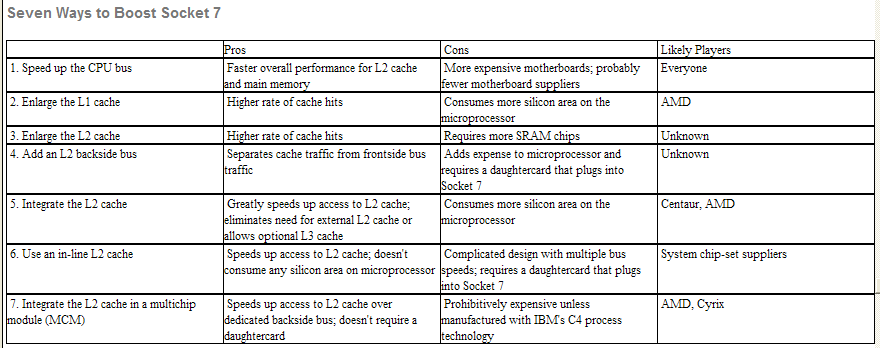 Comparing Peak Bus Bandwidth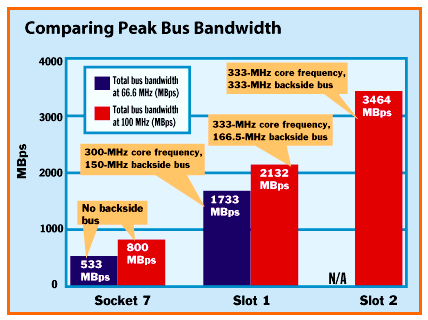 Intel's CPU slots offer
more peak bus bandwidth than Socket 7
because they drive a backside bus at higher frequencies. 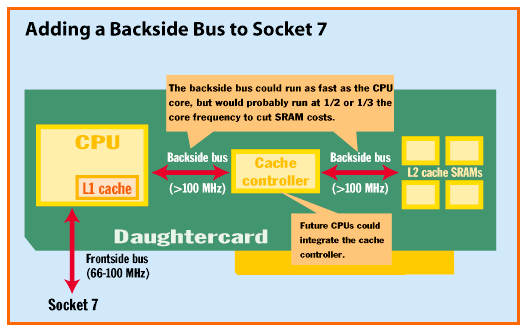 CPU designers could make
a Socket 7-compatible backside bus
by segregating the L2 cache on a daughtercard. Adding an In-Line Cache to Socket 7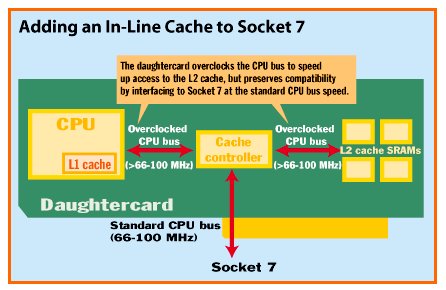 An in-line L2 cache
doesn't require a backside bus,
so it would work with existing processors. Multichip Modules for Socket 7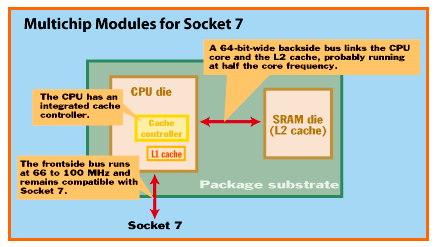 Packaging the L2 cache
in an MCM would deliver the benefits
of a backside bus without the drawbacks of a daughtercard. Tom R. Halfhill is a BYTE senior editor based in San Mateo, California. You can reach him at thalfhill@bix.com. Copyright 1994-1998 BYTE |